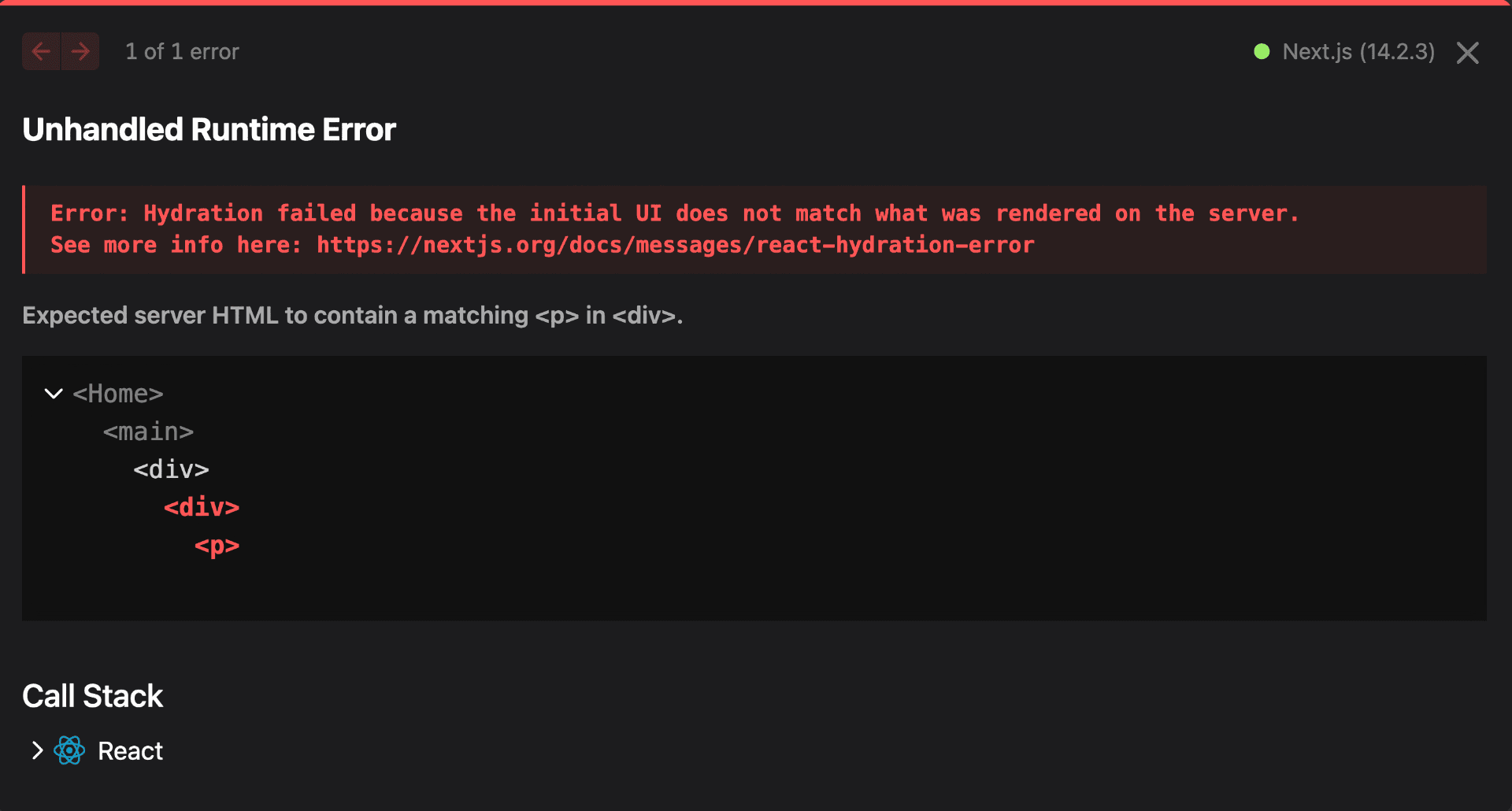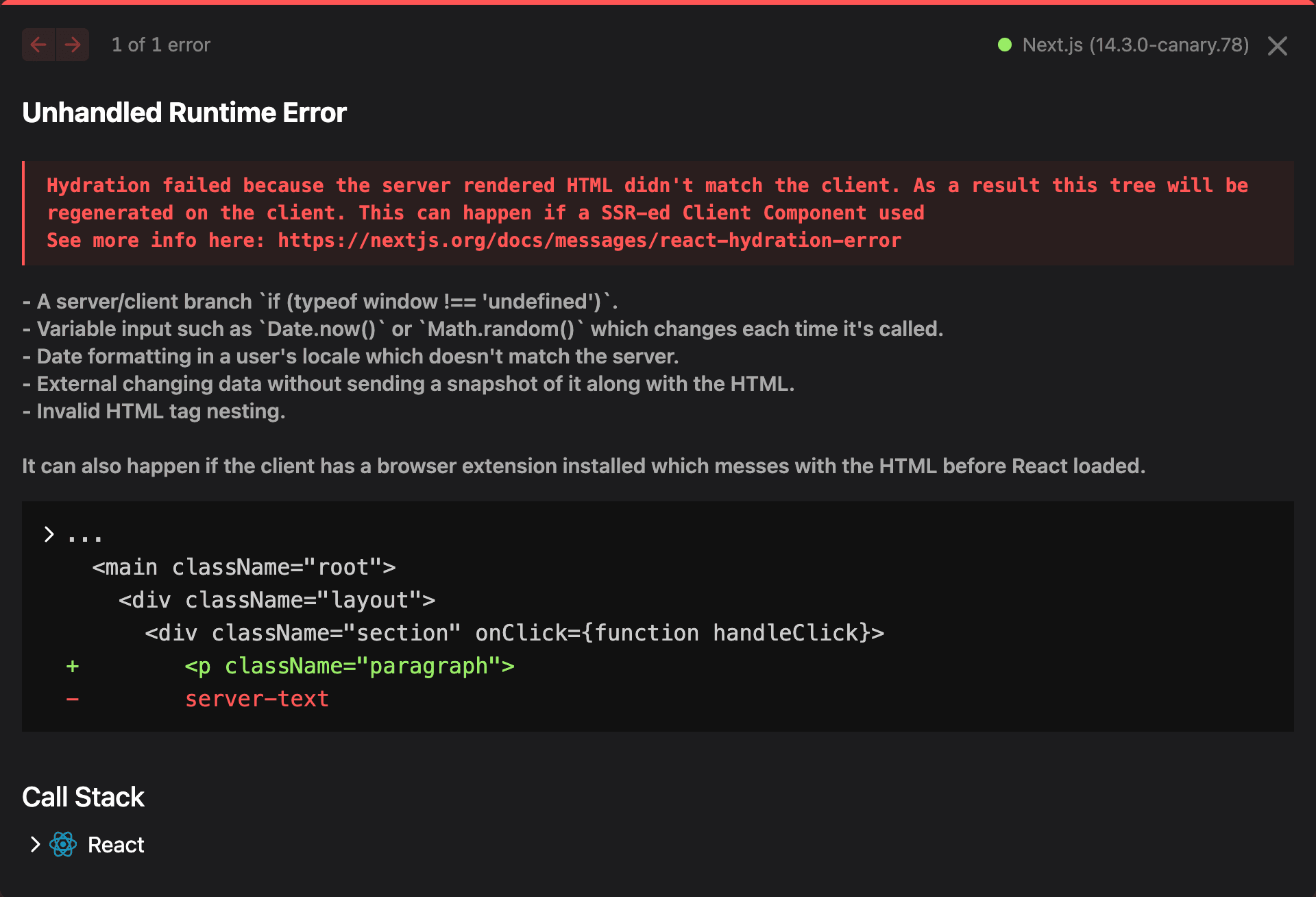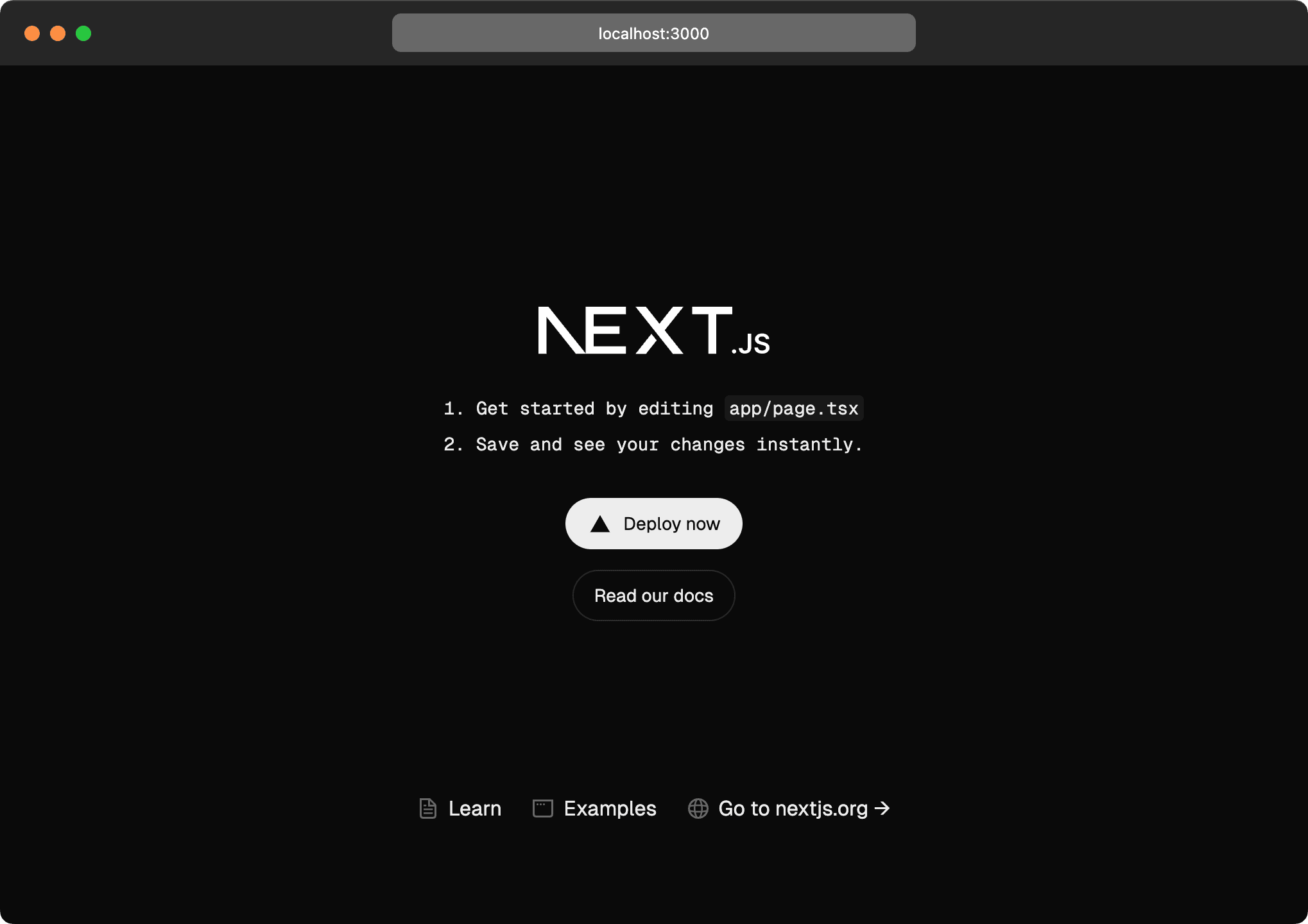Thursday, May 23rd 2024
Next.js 15 RC
Posted byThe Next.js 15 Release Candidate (RC) is now available. This early version allows you to test the latest features before the upcoming stable release.
- React: Support for the React 19 RC, React Compiler (Experimental), and hydration error improvements
- Caching:
fetchrequests,GETRoute Handlers, and client navigations are no longer cached by default - Partial Prerendering (Experimental): New Layout and Page config option for incremental adoption
next/after(Experimental): New API to execute code after a response has finished streamingcreate-next-app: Updated design and a new flag to enable Turbopack in local development- Bundling external packages (Stable): New config options for App and Pages Router
Try the Next.js 15 RC today:
npm install next@rc react@rc react-dom@rcReact 19 RC
The Next.js App Router is built on the React canary channel for frameworks, which has allowed developers to use and provide feedback on these new React APIs before the v19 release.
Next.js 15 RC now supports React 19 RC, which includes new features for both the client and server like Actions.
Read the Next.js 15 upgrade guide, the React 19 upgrade guide, and watch the React Conf Keynote to learn more.
Note: Some third party libraries may not be compatible with React 19 yet.
React Compiler (Experimental)
The React Compiler is a new experimental compiler created by the React team at Meta. The compiler understands your code at a deep level through its understanding of plain JavaScript semantics and the Rules of React, which allows it to add automatic optimizations to your code. The compiler reduces the amount of manual memoization developers have to do through APIs such as useMemo and useCallback - making code simpler, easier to maintain, and less error prone.
With Next.js 15, we've added support for the React Compiler.
Install babel-plugin-react-compiler:
npm install babel-plugin-react-compilerThen, add experimental.reactCompiler option in next.config.js:
const nextConfig = {
experimental: {
reactCompiler: true,
},
};
module.exports = nextConfig;Optionally, you can configure the compiler to run in "opt-in" mode as follows:
const nextConfig = {
experimental: {
reactCompiler: {
compilationMode: 'annotation',
},
},
};
module.exports = nextConfig;Note: The React Compiler is currently only possible to use in Next.js through a Babel plugin, which could result in slower build times.
Learn more about the React Compiler, and the available Next.js config options.
Hydration error improvements
Next.js 14.1 made improvements to error messages and hydration errors. Next.js 15 continues to build on those by adding an improved hydration error view. Hydration errors now display the source code of the error with suggestions on how to address the issue.
For example, this was a previous hydration error message in Next.js 14.1:
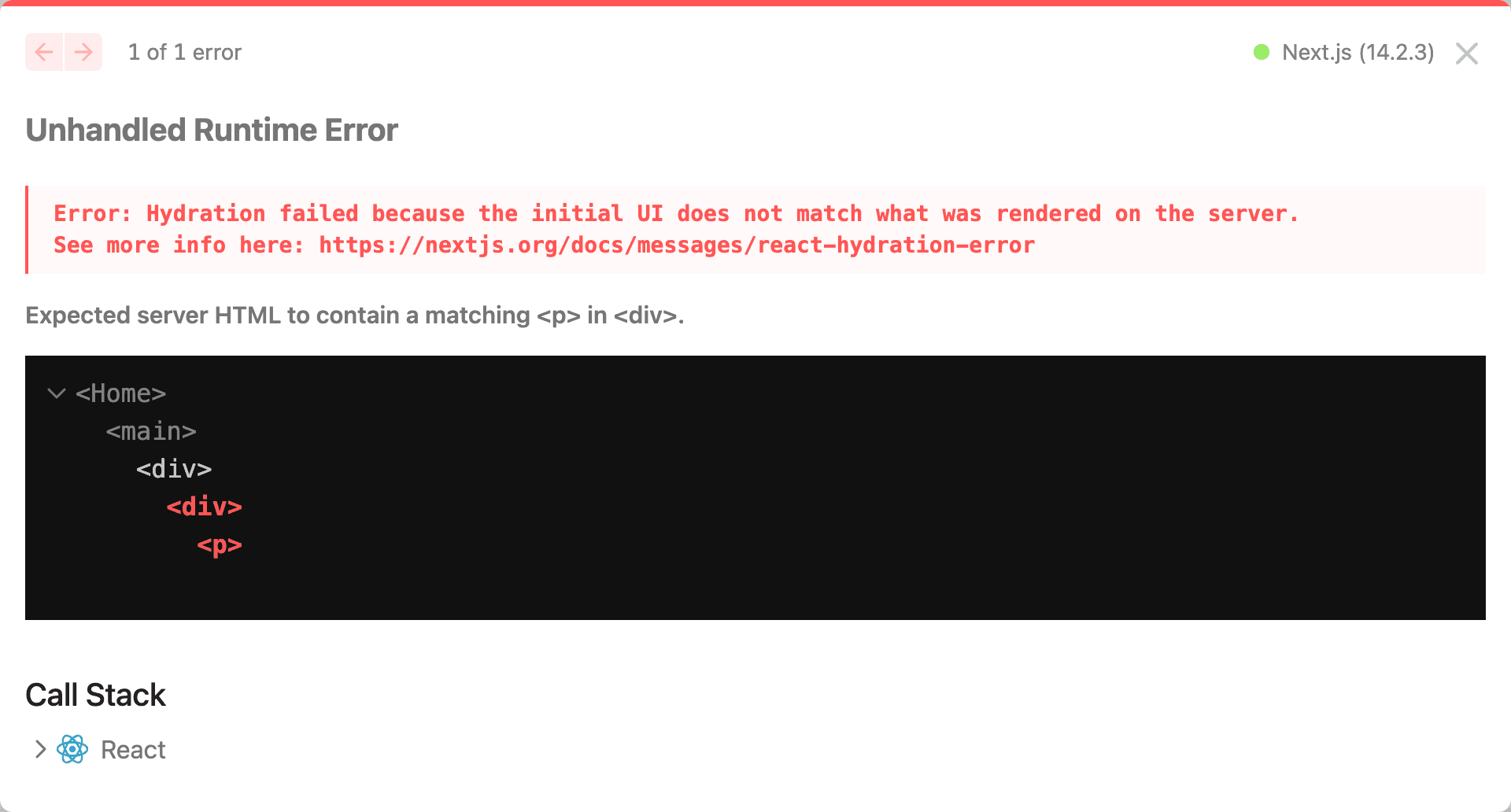
Next.js 15 RC has improved this to:
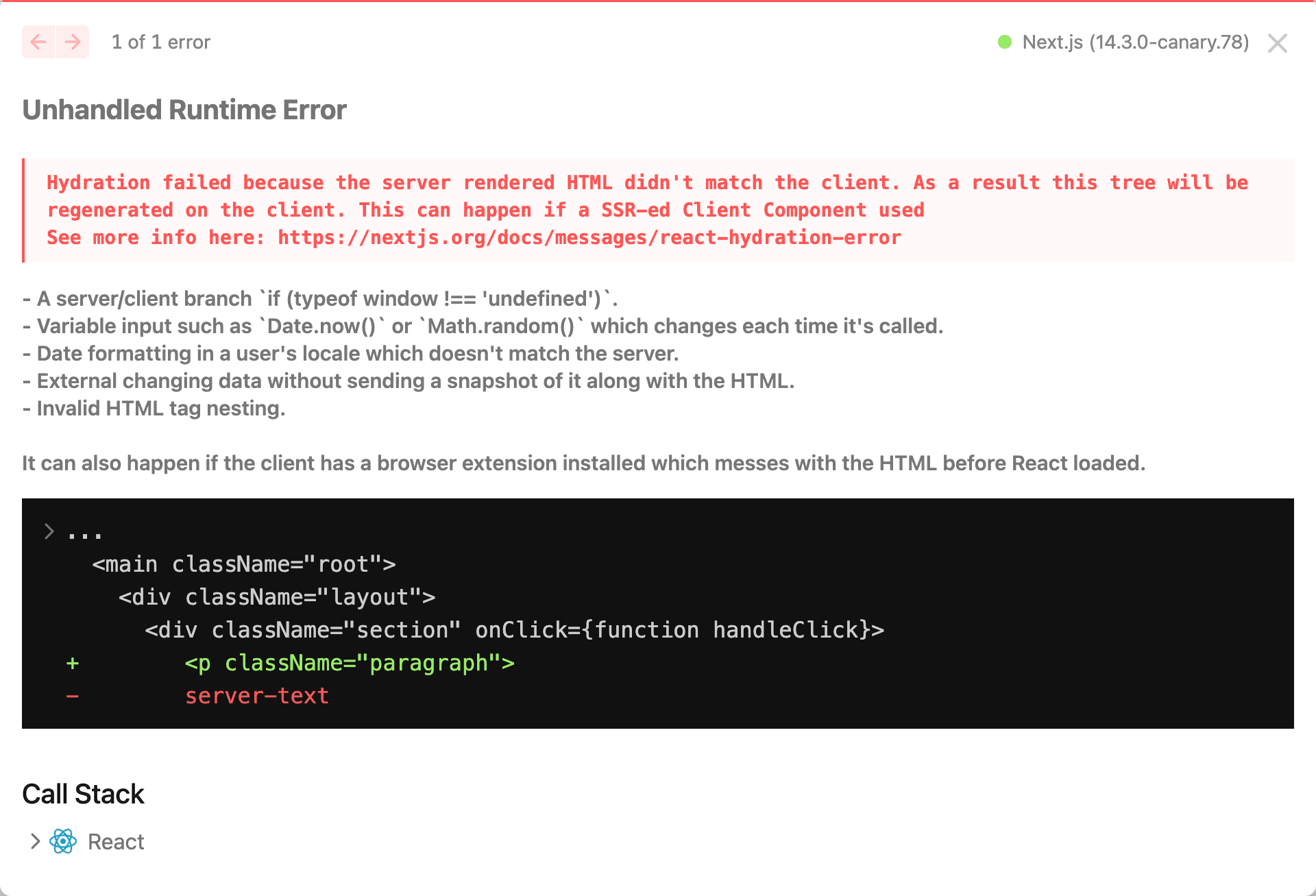
Caching updates
Next.js App Router launched with opinionated caching defaults. These were designed to provide the most performant option by default with the ability to opt out when required.
Based on your feedback, we re-evaluated our caching heuristics and how they would interact with projects like Partial Prerendering (PPR) and with third party libraries using fetch.
With Next.js 15, we’re changing the caching default for fetch requests, GET Route Handlers, and Client Router Cache from cached by default to uncached by default. If you want to retain the previous behavior, you can continue to opt-into caching.
We're continuing to improve caching in Next.js in the coming months and we'll share more details in the Next.js 15 GA announcement.
fetch Requests are no longer cached by default
Next.js uses the Web fetch API cache option to configure how a server-side fetch request interacts with the framework's persistent HTTP cache:
fetch('https://...', { cache: 'force-cache' | 'no-store' });no-store- fetch a resource from a remote server on every request and do not update the cacheforce-cache- fetch a resource from the cache (if it exists) or a remote server and update the cache
In Next.js 14, force-cache was used by default if a cache option was not provided, unless a dynamic function or dynamic config option was used.
In Next.js 15, no-store is used by default if a cache option is not provided. This means fetch requests will not be cached by default.
You can still opt into caching fetch requests by:
- Setting the
cacheoption toforce-cachein a singlefetchcall - Setting the
dynamicroute config option to'force-static'for a single route - Setting the
fetchCacheroute config option to'default-cache'to override allfetchrequests in a Layout or Page to useforce-cacheunless they explicitly specify their owncacheoption
GET Route Handlers are no longer cached by default
In Next 14, Route Handlers that used the GET HTTP method were cached by default unless they used a dynamic function or dynamic config option. In Next.js 15, GET functions are not cached by default.
You can still opt into caching using a static route config option such as export dynamic = 'force-static'.
Special Route Handlers like sitemap.ts, opengraph-image.tsx, and icon.tsx, and other metadata files remain static by default unless they use dynamic functions or dynamic config options.
Client Router Cache no longer caches Page components by default
In Next.js 14.2.0, we introduced an experimental staleTimes flag to allow custom configuration of the Router Cache.
In Next.js 15, this flag still remains accessible, but we are changing the default behavior to have a staleTime of 0 for Page segments. This means that as you navigate around your app, the client will always reflect the latest data from the Page component(s) that become active as part of the navigation. However, there are still important behaviors that remain unchanged:
- Shared layout data won't be refetched from the server to continue to support partial rendering.
- Back/forward navigation will still restore from cache to ensure the browser can restore scroll position.
- Loading.js will remain cached for 5 minutes (or the value of the
staleTimes.staticconfiguration).
You can opt into the previous Client Router Cache behavior by setting the following configuration:
const nextConfig = {
experimental: {
staleTimes: {
dynamic: 30,
},
},
};
module.exports = nextConfig;Incremental adoption of Partial Prerendering (Experimental)
In Next.js 14, we introduced Partial Prerendering (PPR) - an optimization that combines static and dynamic rendering on the same page.
Next.js currently defaults to static rendering unless you use dynamic functions such as cookies(), headers(), and uncached data requests. These APIs opt an entire route into dynamic rendering. With PPR, you can wrap any dynamic UI in a Suspense boundary. When a new request comes in, Next.js will immediately serve a static HTML shell, then render and stream the dynamic parts in the same HTTP request.
To allow for incremental adoption, we’ve added an experimental_ppr route config option for opting specific Layouts and Pages into PPR:
import { Suspense } from "react"
import { StaticComponent, DynamicComponent } from "@/app/ui"
export const experimental_ppr = true
export default function Page() {
return {
<>
<StaticComponent />
<Suspense fallback={...}>
<DynamicComponent />
</Suspense>
</>
};
}To use the new option, you’ll need to set the experimental.ppr config in your next.config.js file to 'incremental':
const nextConfig = {
experimental: {
ppr: 'incremental',
},
};
module.exports = nextConfig;Once all the segments have PPR enabled, it’ll be considered safe for you to set the ppr value to true, and enable it for the entire app and all future routes.
We will share more about our PPR roadmap in our Next.js 15 GA blog post.
Learn more about Partial Prerendering.
Executing code after a response with next/after (Experimental)
When processing a user request, the server typically performs tasks directly related to computing the response. However, you may need to perform tasks such as logging, analytics, and other external system synchronization.
Since these tasks are not directly related to the response, the user should not have to wait for them to complete. Deferring the work after responding to the user poses a challenge because serverless functions stop computation immediately after the response is closed.
after() is a new experimental API that solves this problem by allowing you to schedule work to be processed after the response has finished streaming, enabling secondary tasks to run without blocking the primary response.
To use it, add experimental.after to next.config.js:
const nextConfig = {
experimental: {
after: true,
},
};
module.exports = nextConfig;Then, import the function in Server Components, Server Actions, Route Handlers, or Middleware.
import { unstable_after as after } from 'next/server';
import { log } from '@/app/utils';
export default function Layout({ children }) {
// Secondary task
after(() => {
log();
});
// Primary task
return <>{children}</>;
}Learn more about next/after.
create-next-app updates
For Next.js 15, we've updated create-next-app with a new design.
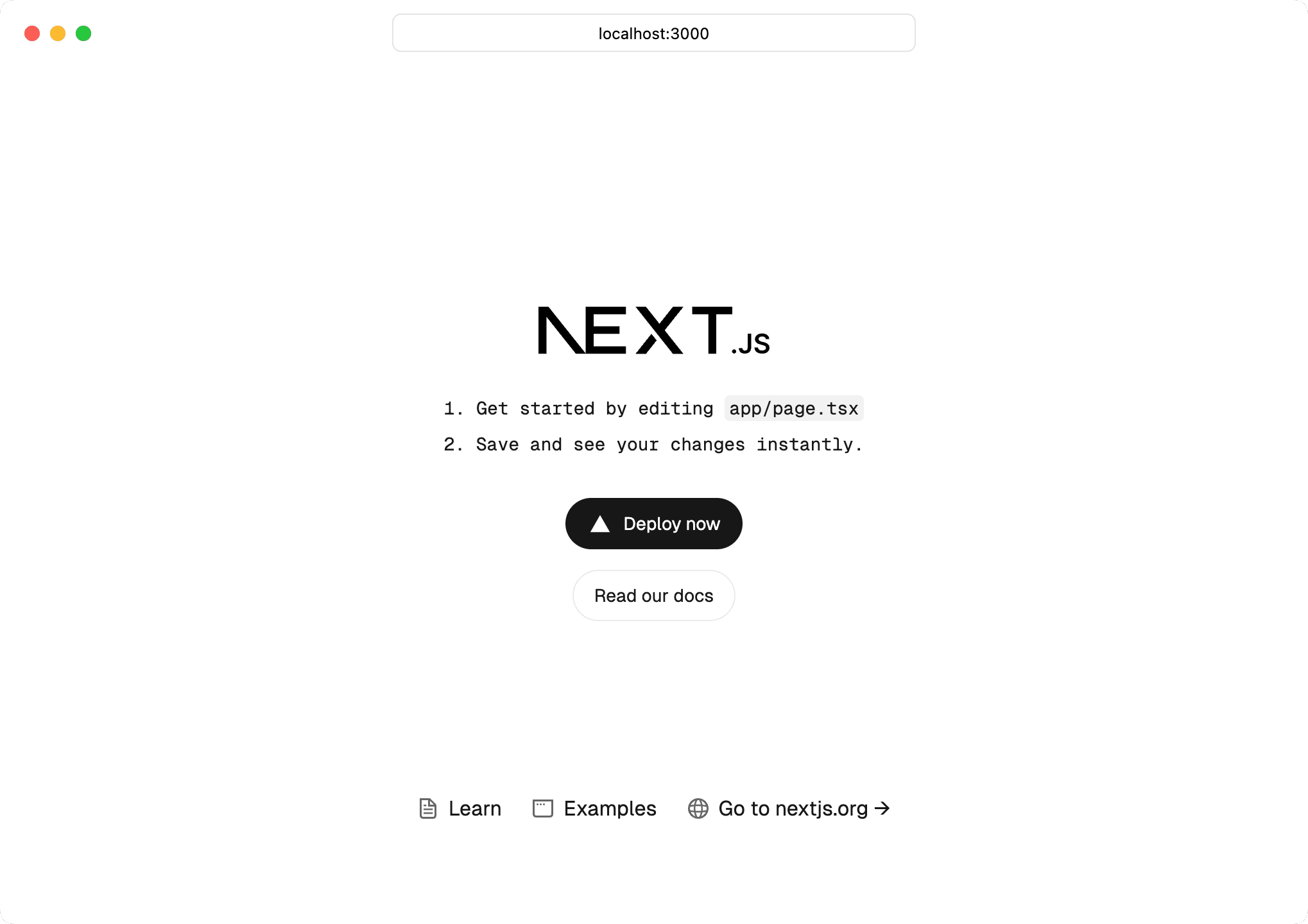
When running create-next-app, there is a new prompt asking if you want to enable Turbopack for local development (defaults to No).
✔ Would you like to use Turbopack for next dev? … No / YesThe --turbo flag can be used to enable Turbopack.
npx create-next-app@rc --turboTo make getting started on a new project even easier, a new --empty flag has been added to the CLI. This will remove any extraneous files and styles, resulting in a minimal "hello world" page.
npx create-next-app@rc --emptyOptimizing bundling of external packages (Stable)
Bundling external packages can improve the cold start performance of your application. In the App Router, external packages are bundled by default, and you can opt-out specific packages using the new serverExternalPackages config option.
In the Pages Router, external packages are not bundled by default, but you can provide a list of packages to bundle using the existing transpilePackages option. With this configuration option, you need to specify each package.
To unify configuration between App and Pages Router, we’re introducing a new option, bundlePagesRouterDependencies to match the default automatic bundling of the App Router. You can then use serverExternalPackages to opt-out specific packages, if needed.
const nextConfig = {
// Automatically bundle external packages in the Pages Router:
bundlePagesRouterDependencies: true,
// Opt specific packages out of bundling for both App and Pages Router:
serverExternalPackages: ['package-name'],
};
module.exports = nextConfig;Learn more about optimizing external packages.
Other Changes
- [Breaking] Minimum React version is now 19 RC
- [Breaking] next/image: Removed
squooshin favor ofsharpas an optional dependency (PR) - [Breaking] next/image: Changed default
Content-Dispositiontoattachment(PR) - [Breaking] next/image: Error when
srchas leading or trailing spaces (PR) - [Breaking] Middleware: Apply
react-servercondition to limit unrecommended react API imports (PR) - [Breaking] next/font: Removed support for external
@next/fontpackage (PR) - [Breaking] next/font: Removed
font-familyhashing (PR) - [Breaking] Caching:
force-dynamicwill now set ano-storedefault to the fetch cache (PR) - [Breaking] Config: Enable
swcMinify(PR),missingSuspenseWithCSRBailout(PR), andoutputFileTracing(PR) behavior by default and remove deprecated options - [Breaking] Remove auto-instrumentation for Speed Insights (must now use the dedicated @vercel/speed-insights package) (PR)
- [Breaking] Remove
.xmlextension for dynamic sitemap routes and align sitemap URLs between development and production (PR) - [Improvement] Metadata: Updated environmental variable fallbacks for
metadataBasewhen hosted on Vercel (PR) - [Improvement] Fix tree-shaking with mixed namespace and named imports from
optimizePackageImports(PR) - [Improvement] Parallel Routes: Provide unmatched catch-all routes with all known params (PR)
- [Improvement] Config
bundlePagesExternalsis now stable and renamed tobundlePagesRouterDependencies - [Improvement] Config
serverComponentsExternalPackagesis now stable and renamed toserverExternalPackages - [Improvement] create-next-app: New projects ignore all
.envfiles by default (PR) - [Docs] Improve auth documentation (PR)
- [Docs]
@next/envpackage (PR)
To learn more, check out the upgrade guide.
Contributors
Next.js is the result of the combined work of over 3,000 individual developers, industry partners like Google and Meta, and our core team at Vercel. This release was brought to you by:
- The Next.js team: Andrew, Balazs, Ethan, Janka, Jiachi, Jimmy, JJ, Josh, Sam, Sebastian, Sebbie, Shu, Steven, Tim, Wyatt, and Zack.
- The Turbopack team: Alex, Benjamin, Donny, Leah, Maia, OJ, Tobias, and Will.
- Next.js Docs: Delba, Steph, Michael, Anthony, and Lee.
Huge thanks to @devjiwonchoi, @ijjk, @Ethan-Arrowood, @sokra, @kenji-webdev, @wbinnssmith, @huozhi, @domdomegg, @samcx, @Jaaneek, @evanwinter, @wyattjoh, @kdy1, @balazsorban44, @feedthejim, @ztanner, @ForsakenHarmony, @kwonoj, @delbaoliveira, @stipsan, @leerob, @shuding, @xiaohanyu, @timneutkens, @dvoytenko, @bobaaaaa, @bgw, @gaspar09, @souporserious, @unflxw, @kiner-tang, @Ehren12, @EffectDoplera, @IAmKushagraSharma, @Auxdible, @sean-rallycry, @Jeffrey-Zutt, @eps1lon, @jeanmax1me, @unstubbable, @NilsJacobsen, @PaulAsjes, @adiguno, @ryan-nauman, @zsh77, @KagamiChan, @steveluscher, @MehfoozurRehman, @vkryachko, @chentsulin, @samijaber, @begalinsaf, @FluxCapacitor2, @lukahartwig, @brianshano, @pavelglac, @styfle, @symant233, @HristovCodes, @karlhorky, @jonluca, @jonathan-ingram, @mknichel, @sopranopillow, @Gomah, @imddc, @notrab, @gabrielrolfsen, @remorses, @AbhiShake1, @agadzik, @ryota-murakami, @rishabhpoddar, @rezamauliadi, @IncognitoTGT, @webtinax, @BunsDev, @nisabmohd, @z0n, @bennettdams, @joeshub, @n1ckoates, @srkirkland, @RiskyMH, @coopbri, @okoyecharles, @diogocapela, @dnhn, @typeofweb, @davidsa03, @imranolas, @lubieowoce, @maxhaomh, @mirasayon, @blvdmitry, @hwangstar156, @lforst, @emmerich, @christian-bromann, @Lsnsh, @datner, @hiro0218, @flybayer, @ianmacartney, @ypessoa, @ryohidaka, @icyJoseph, @Arinji2, @lovell, @nsams, @Nayeem-XTREME, @JamBalaya56562, @Arindam200, @gaojude, @qqww08, @todor0v, @coltonehrman, and @wiesson for helping!
